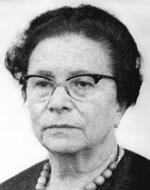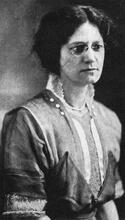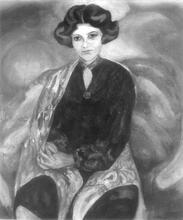Gloria Gervitz
The poet Gloria Gervitz was born in Mexico City to Mexican Ashkenazi parents. Over 44 years, Gervitz wrote her critically acclaimed, book-length poem, Migraciones (Migrations), a book in constant transformation and growth over 44 years. Gervitz’s poem is an epic journey in free verse through the individual and collective memories of Ashkenazi women emigrants to Mexico, ranging across 2,000 years of poetry, spanning the oracles of ancient Greece and the markets of modern Mexico, blending the Jewish and Catholic liturgies, and reclaiming her own voice and erotic power through poetry. She died in 2022 in her adopted home of San Diego, two years after completing her life’s work.
Early Life, Education, and Family
Gloria Gervitz, author of a single poem, the monumental work Migrations (Migraciones), was born in Mexico City on March 29, 1943, to Fay and Rosendo Gervitz. Three of her grandparents had immigrated to Mexico from Poland and the Ukraine in the early twentieth century, as had her father, who was nearly nine years old when he and his family arrived in Mexico from Russia in 1929. Her maternal grandmother, a Catholic woman from Puebla, Mexico, converted to Judaism to marry her grandfather. Gervitz had two younger brothers.
Gervitz grew up in the Jewish enclave of Mexico City, in the Polanco district, and was educated in Jewish schools, attending the Nuevo Colegio Israelita through middle school and the Colegio Israelita de México for high school. Many of her teachers belonged to the socialist and Yiddish Bundist movement founded in Vilna at the end of the nineteenth century. “I’ll always be grateful to them,” she noted, “because they taught us the great tradition of Yiddish literature, the importance of the Jews of the Diaspora, and they imbued me with pride in this heritage of Jews in exile, of that farshvotener velt, that lost word” (Migrations: Poem, 1976–2020, p. 276). In her youth, Gervitz was an active and award-winning swimmer in the newly created Club Deportivo Israelita (Israelite Sports Club). In 1958, she won first prize in a competition that drew more than 2,000 contestants from many Jewish schools, with an essay titled “10 Yor Medinat Israel” (“Ten Years of the State of Israel”; unpublished correspondence with Abraham Maczka).
Though Gervitz was deeply steeped in Ashkenazi Jewish immigrant culture and education, Catholic Mexico played an important role in her childhood as well. She recalled that her indigenous nanny would take her to Mass and her maternal grandmother’s Catholicism persisted despite her conversion. Growing up in both cultures, Gervitz always thought of herself as having a single identity: Mexican and Jewish. “[I] grew up with both things, and in my case, it didn’t present a conflict,” she later reflected. “I saw that some of my schoolmates almost felt they had to choose between being a Jew or a Mexican. But for me, it was pretty clear that I was simply Mexican and Jewish—there was no contradiction” (Migrations, pp. 276–277). Her deep roots in both Jews of European origin and their descendants, including most of North and South American Jewry.Ashkenazi Jewish and Mexican cultures anchored Gervitz’s expansive and inclusive writing from the start.
Gervitz studied Art History at the Universidad Iberoamericana, where she got her bachelor’s degree. She married as a young woman and had a daughter, Denise. In her late twenties, she married her second husband, fellow poet and fine furniture maker, Eduardo Santos, whom she met in 1971 at a poetry workshop at the Universidad Nacional Autónoma de México (National Autonomous University of Mexico). In 2011, she moved from Mexico City, where she had lived her whole life, to San Diego, to be closer to the love of her life, Abraham Maczka, a Mexican-born Ashkenazi Jew who grew up in the same Jewish community in Mexico City as Gervitz and whom she met in San Diego when visiting friends. They were married on November 1, 2018.
From the 1980s to the early 2000s, in addition to her periodic but constant work writing, editing, and publishing her poetry, Gervitz lectured on literature and led poetry workshops throughout Mexico. She was a member of the Mexican Sistema Nacional de Creadores de Arte (National System of Artistic Creators) from 1997 to 2003, 2012 to 2014, and 2015 to 2017.
Gervitz lived in San Diego until her death, on April 19, 2022, of lung cancer.
The Evolution and Reception of Migraciones
Starting in 1976 and continuing over the next 44 years, Gervitz wrote what turned out to be her life’s work: a single, ever-growing, ever-transmuting poem, whose final edition was Migraciones: Poema, 1976–2020, published in English in 2021 as Migrations: Poem, 1976–2020 (translation by Mark Schafer). Gervitz’s poem is an epic journey in free verse through the individual and collective memories of Jewish women emigrants from Eastern Europe, a conversation ranging across 2,000 years of poetry, a bridge spanning the oracles of ancient Greece and the traditional markets of modern Mexico, a prayer blending the Jewish and Catholic liturgies, and a reclamation through poetry of her own voice and erotic power.
Gervitz’s masterwork is a poem that grew like a tree. From its first appearance in print in 1979 to its final publication in 2020, new rings encompassed old ones and limbs and branches emerged from the trunk, with some falling away, as Gervitz expanded, revised, and distilled her poem, a text in constant transformation. In 1976, she wrote the first four lines of what would become Shajarit (Shacharit), a nineteen-page chapbook she self-published in 1979, named for the morning prayer in Judaism. Seven years later, Gervitz published Fragmento de una ventana (Fragment of a Window), which incorporated and expanded on Shajarit; in 1987, Yiskor (Yizkor) appeared, named for the opening word of the Ashkenazi Jewish memorial prayer service, and this book in turn subsumed and expanded on Fragmento de una ventana.
Gloria Gervitz reading from Migraciones with Mark Schafer reading from Migrations, his translation into English of Gervitz’s poem, hosted by the Community Bookstore, Brooklyn, NY (November 24, 2021).
In 1991, when Mexican publisher Fondo de Cultura Económica proposed publishing her poetry in a single volume, Gervitz gave the new book—now a single poem, her only work—its permanent title, Migraciones (Migrations). Commenting on this title in 2021, the poet noted that “the poem has outside migrations, but mostly they’re inside migrations. There were also migrations of myself into other selves, as we’re always migrating within ourselves” (Migrations, p. 279). This new title could not have been more apt: over the next 29 years, the poem migrated through eight distinct editions of the “complete” work. During this time, Gervitz published four initially separate poems—“Pythia” (1993), “Equinoccio” (Equinox) (1996), “Septiembre” (September) (2003), and “Blues” (2014)—all of which she later incorporated, in full or in part and always with significant revisions, into Migraciones. Though the 1991 edition gave her poem its final, encompassing title, the text went through multiple transformations after that first edition, right up until its final version, published in 2020, including the incorporation of all four poems published after 1991. In all her pruning, grafting, writing, and rewriting, Gervitz was always guided, as she described it on multiple occasions, by what the poem itself wanted, asked, demanded of her.
The final, most dramatic, and most radical transformation of the poem occurred in 2016. Ever since the 1991 edition, the published poem had always been divided into sections, each one with a number, a subtitle, and an epigraph. As Gervitz was reviewing final galleys for the 2016 Spanish Paso de Barca edition, she had what she later described as a “revelation”: “Seeing the poem all together, I suddenly realized that I had to remove all those sections, all the epigraphs. I suddenly realized that those capital letters were stopping the poem’s flow.… And the commas just made the poem dirty. It was almost like the poem told me, ‘I have to flow. Take all of it out, it’s stopping my flow.’ At that moment I saw that all these different elements were like dikes, and I just had to take them out and let the poem flow, flow freely” (Migrations, pp. 278–279). Gervitz was finally publishing the poem as it had always been for her, but which she had been too scared to show to readers without the various structural and typographical elements that had characterized and domesticated the poem since its earliest editions. She considered the 2020 Spanish libros de la resistencia edition, Migraciones. Poema 1976–2020, the definitive version of her poem.
Despite a slowly growing critical recognition of Gervitz’s work, it remained in relative obscurity among readers in the Spanish-speaking world, due in part to the work’s size, difficulty, and ever-transformative nature, as well as its extensive Jewish content. However, critics in Mexico and beyond now consider Gervitz to be one of the most significant poets of her generation and Migraciones to be a masterpiece of modern Mexican and Latin American literature. The United States poet Forrest Gander called Migrations one of the great poems of the 21st century and several critics have characterized Gervitz’s work as one of the great poetic projects of modern times. Ilan Stavans, in his introduction to I Am of the Tribe of Judah: Poems from Jewish Latin America, described his impression that “all of Jewish Latin American poetry is contained in Migrations, which represents its crowning achievement” (I Am of the Tribe of Judah, p. 21).
Homage to Gloria Gervitz in the Palacio de Bellas Artes, Mexico City (in Spanish) (April 15, 2018).
Gervitz won three literary prizes and a number of fellowships. In 1986, she was awarded the Fernando Jeno Prize, the international prize for Jewish literature given by the Jewish community of Mexico, for Fragmento de ventana. Seven years later, she was awarded a poetry fellowship from the Fondo Nacional para la Cultura y las Artes (National Fund for Culture and Arts). In 1995, she received a grant from the Fund for Culture Mexico-U.S. to translate the poetry of Lorine Niedecker. In 2011, Gervitz was awarded the PEN Mexico Prize for Literary Excellence, and in 2019, the Chilean Ministry of Cultures, Arts and Heritage named her the winner of the Pablo Neruda Ibero-American Poetry Award, a highly prestigious literary award in the Spanish-speaking world.
Gervitz’s complete poem has been translated into English, Arabic, German, Swedish, Greek, Norwegian, Polish, Italian, Russian, and Danish. Selections from Migraciones have been translated into at least eleven other languages, including Hebrew, Italian, Japanese, Portuguese, and Slovenian.
Jewishness, Multilingualism, and Gynocentric Presence in Gervitz’s Poetry
Migraciones is peppered with lines from and references to Jewish liturgy and textual traditions. Chilean poet and professor Marjorie Agosín considers Gervitz to be one of the most powerful and original voices of contemporary Jewish Latin American literature, and Mexican author Ethel Krauze wrote that Gervitz’s poem “is the quintessential example of the recovery of memory of the Jewish spirit, peeled away, layer after layer…. [Like] a good Jew, [Gervitz] wrote a single book that, in its own way, is an infinite one” (Gobierno de México). The author herself once noted that the unanswered and unanswerable questions that fill her poetry are “where my Jewish heritage is most present, like the scholars of the Lit. "teaching," "study," or "learning." A compilation of the commentary and discussions of the amora'im on the Mishnah. When not specified, "Talmud" refers to the Babylonian Talmud.Talmud, whose many interpretations are simply questions in another form” (“Reflexiones y agradecimientos de la autora,” unpublished essay, dated December 2021).
Migraciones is a multilingual poem; while primarily written in Spanish, it also contains passages in English, Yiddish, Aramaic, and Hebrew, as well as traces of Portuguese, Nahuatl (one of Mexico’s indigenous languages), and classical and modern Greek. The poem references classical Greek, Japanese, and Chinese literatures, as well as contemporary English-language literatures, and quotes the poetry of William Blake, William Butler Yeats, Charles Olson, and Lorine Niedecker, among others.
From its inception, Gervitz’s poetry was centered in the feminine: female experiences and perspectives, feminine voices, and female archetypes. For the first twenty years, her writing appeared to be set in a pre-male universe, with its frequent eroticism being masturbatory or non-phallocentric. Until the 1996 edition of the poem, when the masculine you in Spanish briefly appeared for the first time, the voices and figures in Migraciones, whether human (like her mother or grandmother) or conceptual (like the Word and Poetry) were all feminine, as indicated by their gendered endings in Spanish. In the 2017 edition of the poem an overtly heterosexual eroticism entered the text, yet Gervitz’s poem remained a chorus of exclusively female voices. In 2003, the author described the voice of her book as being the archetypical feminine spirit. Years later, she expanded on this idea, noting that “the archetypal mother … [is] really at the center of everything.… Why the woman at the center? Because in many ways, I wasn’t considered worthwhile in my family because I was a woman. To have this female principal as the protagonist of the book, to put it at the center, was for me an act of self-affirmation, a way of claiming my freedom” (Migrations: Poem, 1976-2020, p. 283).
Translation and Collaboration
Though Gervitz’s creative production was entirely textual, she conceived of her poetry in visual terms as well, and the way she arranged the words and lines on the page—with lines emerging from the blank page, cascading down and across the page, or a few words placed at the top or bottom of the page—was as essential to her poetry as its content. “I am a very visual person,” she commented in in 2004. “[The] world enters me through my eyes: lights, colors, forms, objects, landscapes.… The way I place the text on the page has so much to do with that visual sense—I think of the book as a visual object” (Migrations/Migraciones, p. 152–153). Gervitz frequently collaborated with female visual artists, including Rowena Morales, Julia Giménez Cacho, Magali Lara, Kerro Holmberg, and Luz María Mejía, incorporating their artwork in her books as illustrations and book covers and even into her poetry. (In Gervitz’s five-part 1993 chapbook “Pythia,” part V is comprised solely of three collotypes by Luz María Mejía.)
Though Gervitz did not consider herself primarily a translator, she rendered the work of a wide range of authors into Spanish for magazines and anthologies, including poetry by Anna Akhmatova, Samuel Beckett, Kenneth Rexroth, Lorine Niedecker, Rita Dove, Marguerite Yourcenar, Susan Howe, Clarice Lispector, and Osip Mandelstam (translating the Russian poets based on English translations of their works.)
Note: All quotes from the Spanish were translated into English by Mark Schafer.
Unpublished Papers
The Estate of Gloria Gervitz donated her papers to the Universidad Iberoamericana in Mexico City, where they are being archived under the supervision of Professor Tania Favela Bustillo.
Selected Works by Gloria Gervitz
Shajarit. Mexico City: Self-published, Imprenta Madero, S. A. 1979.
Fragmento de ventana. Mexico City: Editorial Villicaña, S.A., 1986.
Pythia. Mexico City: Mario del Valle, 1993.
Migrations/Migraciones. Translated by Mark Schafer. New York City: Junction Press, 2004.
“Algo sobre el poema Migraciones.” El poeta y su trabajo, no. 34 (2009): 23–34.
“Entrevista a la poeta mexicana Gloria Gervitz.” Interview with introduction by Irene Zoe Alameda, September 2010, https://www.irenezoealameda.com/blog/entrevista-la-poeta-gloria-gervitz, accessed July 21, 2022.
Migraciones: Poema 1976–2020. Madrid: libros de la resistencia, 2020.
“Interview to poet Gloria Gervitz.” With Irene Zoe Alameda. https://www.irenezoealameda.com/en/journalism/interviewer/interview-mexican-poet-gloria-gervitz.
“Gloria Gervitz y ‘Migraciones’: el poema de una vida.” Interview by Diego José. Milenio, July 26, 2019, accessed 16 July 2022. https://www.milenio.com/cultura/laberinto/llevo-42-anos-conviviendo-poema-gloria-gervitz.
“Gloria Gervitz y el eterno poema.” Interview and introduction by María Negroni. Liberantes, March 20, 2020, accessed 21 July 2022. https://www.librerantes.com/migraciones-poema-1976-2020-por-que-este-libro/.
“Viví para esto, para estar en el poema, para esperarlo, para recibirlo cuando llegara.” Interview and introduction by Esther Peñas. Contexto y Acción, no. 269 (February 2021), accessed July 14, 2022. https://ctxt.es/es/20210201/Culturas/35097/gloria-gervitz-poeta-entrevista-migraciones.htm.
Migrations: Poem, 1976-2020. Translated by Mark Schafer. New York City: New York Review of Books, 2021.
“Reflexiones y agradecimientos de la autora.” Unpublished essay. December 2021.
Migraciones 1976-2020. Mexico City: Universidad Iberoamericana and Mangos de Hacha, 2024.
Instituto Nacional de Bellas Artes y Literatura. “Gervitz, Gloria (1943-2022).” Accessed January 5, 2024. https://literatura.inba.gob.mx/ciudad-de-mexico/3732-gervitz-gloria.html.
Favela Bustillo, Tania. “La inmersión en las aguas.” Diario ContraRéplica, December 14, 2018. Accessed July 7, 2022. https://www.contrareplica.mx/nota-la-inmersion-en-las-aguas2018141248.
Favela Bustillo, Tania. “In memoriam Gloria Gervitz (1943-2022).” Periódico de poesía, April 25, 2022. Accessed July 26, 2022. https://periodicodepoesia.unam.mx/texto/in-memoriam-gloria-gervitz-1943-2022/#43.
Minc, Rose S. “Fragmento de ventana”: hacia una hagiografía de las olvidadas.” Folio: Latin American Jewish Writers, no. 17 (1987).
Moscona, Myriam. “Siempre estamos migrando: Crónica de una amistad.” La Razón de México, April 29, 2022, accessed 19 July 2022. https://www.razon.com.mx/el-cultural/siempre-migrando-cronica-amistad-480599.
Rodríguez, Blanca. “El cuerpo de la escritura. Una mirada a la obra de Gloria Gervitz.” Tópicos del Seminario, no. 16 (July–December 2006): pp. 93-117, accessed July 30, 2022. http://www.redalyc.org/articulo.oa?id=59401604.
Gobierno de México. “Gloria Gervitz preservó en su obra la tradición literaria judía,” April 20, 2022, accessed January 5, 2023. https://www.gob.mx/cultura/prensa/la-poeta-gloria-gervitz-preservo-en-su-obra-la-tradicion-literaria-judia
Sadow, Stephen A., ed. I Am of the Tribe of Judah. Albuquerque, NM: University of New Mexico Press, 2024.




















